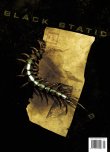
“The Lonely Heart” by Aliette De Bodard
“The Plain” by Tim Lees
“Haunt-Type Experience” by Roz Clarke
“The Pain of Blue Eyes” by Daniel Kaysen
“Changeling” by Al Robertson
“Fear” by Setphen Volk
Reviewed by Bill Ward
Issue #9 of Black Static starts off with “The Lonely Heart” by Ailette De Bodard, a tale of ghosts and demons in modern China. When kind-hearted Chen gets involved protecting a child prostitute, she soon finds herself embroiled in grisly supernatural dealings. The story unwinds slowly, building character and mood, and utilizes the backdrop of a changing China as a smart counterpoint to the traditional spook story at its core, where lust and necessity clash over the heart of one man.
Professor Nick Balchin is feeling rather uneasy about the changes he’s noticing in his colleagues lately in Tim Lees’ “The Plain,” the revolting way they eat, their disgusting bestial features, and the animalistic behaviors they seem to exhibit. But is this supposed devolution, as he suspects, all in his mind? A cerebral story about paranoia and academia as seen through the prism of ‘nature red in tooth and claw,’ “The Plain” is a compelling little gem of a story that aims more to evoke a sense of disquiet than horror with a capital ‘H.’ Special marks go toward Lees’ superb use of voice and dialog to carry the characterization and bring the insular world of academia to life.
“Haunt-Type Experience” by Roz Clarke at first seems as if it will be another ‘paranormal investigators tackle haunted house’ story, but quickly diverges into different territory. Megan, the central character, is sensitive to so-called ‘haunt-type’ experiences, and endures a terrifying ordeal of sleep paralysis that summons up her own feelings of guilt and horror as part of an investigation into haunting phenomena. A well-told piece, interspersed with quotations from an actual article on paranormal experience.
When meek Brian becomes the exclusive punching bag of uber-bully Richie, his life actually gets better, at least for a while, in Daniel Kaysen’s “The Pain of Blue Eyes.” But that doesn’t last, and soon he finds himself digging graves and participating in murder. A sharp, tight tale about dark transformations, human predators, and the thrill of the kill that makes a compelling read despite having little in the way of empathetic characters.
As might be expected from the title, Al Robertson’s “Changeling” deals with the fairy folk – those mysterious, fey, and dangerous beings that lurk out in the deep woods. But this tale has a modern twist, when a psychologically damaged veteran drives his family into the arms of the fairy folk and tries to get them back by brutal means. An interesting take on an old classic, with war-guilt and post-traumatic stress disorder functioning as the human sin that spurs conflict with the inhuman ‘others.’
Like the first story of the issue, the last takes us to Asia, though this time to classical Japan’s ‘Heisam’ Period (perhaps a fictionalized rendering of the more familiar Heian Period), but unlike “The Lonely Heart,” Stephen Volk’s “Fear” is less about evoking period details and more about moving on toward the punch line. I say ‘punch line’ because the climax of this almost tongue-in-cheek tale of a fearless Samurai named Hojo confronting ghosts hits like one, and like any good punch line it has a way of excusing what comes before it.
Overall a fine variety of stories, all of which eschew the conventional to bring us a different perspective on horror. Combined with Black Static’s usual excellent and edgy writing in news, reviews, and other non-fiction content, Issue Nine is a compelling read from cover to cover.